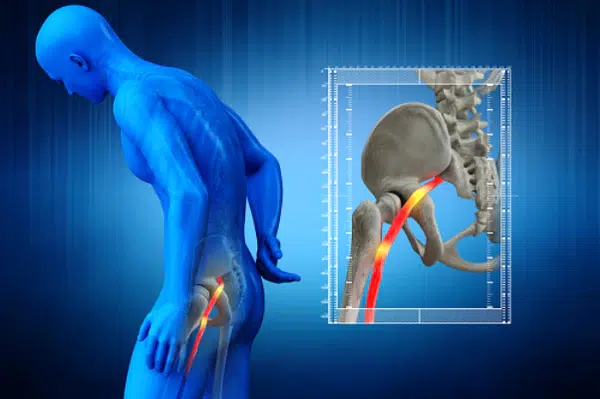Sciatica is a painful condition that occurs when the sciatic nerve becomes pinched, inflamed, or irritated. The sciatic nerve runs from the lower back and gluteal area down the back of the legs. Sciatic pain can be mild to severe, but it’s always accompanied by other symptoms of discomfort such as leg numbness, muscle weakness, tingling, or swelling.
For most people, this condition goes away on its own within a few weeks to months. However, treatment can help reduce sciatica pain and increase mobility.
What Is Sciatica?
Sciatica is a medical term used to describe pain caused by the compression of one of the primary nerves of your spinal cord, the sciatic nerve. The nerve starts high in the buttock or lower back (the sciatic notch) and travels down the back of the thigh towards the knee. Sciatic nerve pain can include acute back pain and leg pain.
If you suffer from sciatica, there are different chiropractic treatments available, including spinal manipulation and other chiropractic adjustments, to help relieve pain.
What Causes Sciatica?
Sciatica is the symptom of an underlying problem with your spine. Some causes of sciatica include:
- Disc bulge/herniated disc
- Bone spurs pressing against the nerve root
- Injury to the surrounding muscles
- Inflammation of the piriformis muscle
Many conditions can lead to sciatica, including:
- Arthritis in the hip joint
- Fibromyalgia
- Lumbar degenerative disc disease
- Sports-related injuries
- Osteoporosis
Symptoms of Sciatica
The following are the common sciatica symptoms:
- Sharp shooting pain down one leg
- A tingling sensation felt along the affected limb
- Numbness/tingling sensations felt in the thighs
- Painful muscle spasms
- Weakness and heaviness in the muscles affected
- Difficulty walking
If you’re experiencing any kind of low back or leg pain, speak to our sciatica pain relief specialists at 630-317-7478 today about possible treatment options.
Treatments for Sciatica
The best way to treat sciatica is to address the source of the condition. In most cases, sciatica resolves itself over time, but specific measures should be taken to keep it under control. If you’ve been diagnosed with sciatica, here are things to consider:
Chiropractic Treatment
Chiropractic care effectively reduces inflammation and relieves pressure on your sciatic nerve. Chiropractors will use spinal adjustments combined with specific exercises to relax tight areas around your spine and provide relief from pain. Your chiropractor might recommend stretching exercises along with strengthening programs and spinal manipulations.
Sciatica chiropractic treatment techniques include the following:
- Spinal manipulation
- Spine mobilization
- Postural corrections
- Heat therapy
- Transcutaneous electrical nerve stimulation
- Trigger point injections
Physical Therapy
Depending on how much pain and stiffness you experience, physical therapists can help strengthen weak core muscles and improve flexibility so you can avoid further injury. They can also work with you to develop new exercise routines that strengthen your abdomen and back. A typical physical therapy program includes:
- Total body vibration plates
- Nerve decompression
- Stretching
- Massage
Massage Therapy
Massage therapy uses light pressure to release tension in muscles and joints as a relaxing hands-on treatment. Deep tissue massages are sometimes used to treat chronic conditions. Massage therapy has been shown to decrease pain and increase flexibility in the hips and low back, making patients less likely to develop future problems like sciatica.
Sciatica affects 10% to 40% of people at some point during their lifetime. It often begins with what appears to be a sudden sharp shooting pain down one or both legs from the lower back to the feet. If you experience any of these symptoms, consult our pain relief doctor immediately.


